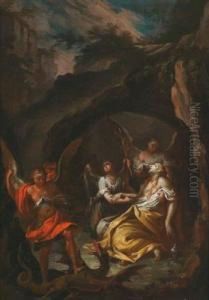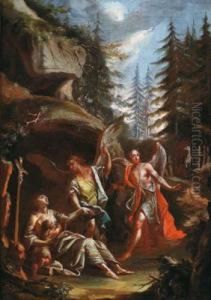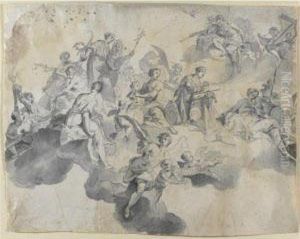Johannn Jakob Zeiller Paintings
Johann Jakob Zeiller was a prominent figure in the 18th-century European art scene, known for his contributions as a painter, particularly in the realm of fresco painting. Born on July 8, 1708, in Reutte, Tyrol, in what is today Austria, Zeiller came from a family with artistic roots, which likely influenced his early inclinations towards art. His father, Franz Anton Zeiller, was also a painter, providing Johann Jakob with an environment steeped in artistic endeavors from a young age.
Zeiller's education and artistic training were comprehensive, embodying the practices and expectations of his time. He embarked on his journey in the arts by studying under his father before moving to Augsburg to further his education. It was here that he became a student of Johann Georg Bergmüller, a well-regarded painter of the time, under whose guidance Zeiller honed his skills in painting, particularly in fresco, which would come to define much of his career.
His work and reputation soon led him to Italy, the heartland of Renaissance art and a pivotal location for any artist seeking to delve deeper into the classical roots of European art. In Italy, Zeiller was exposed to the works of the great masters, and he studied the techniques and principles that underpinned their creations. This period was crucial in shaping his artistic direction and philosophy. Upon returning to the German-speaking lands, Zeiller embarked on a prolific period of creating altarpieces, frescoes, and oil paintings, often imbued with the influences of Italian art, particularly the Baroque and Renaissance styles.
Throughout his career, Johann Jakob Zeiller was best known for his frescoes in churches and secular buildings across southern Germany and Austria. His works are characterized by their dynamic compositions, vibrant use of color, and the integration of architectural elements into his paintings, creating immersive, spiritual, and visually compelling pieces. Among his most significant contributions are the frescoes in the Abbey Church of Ottobeuren and the Pilgrimage Church of Wies, which stand as testaments to his skill and artistic vision.
Zeiller's impact on the art world extended beyond his own works. He was a mentor to younger artists, passing on the techniques and ideals he had acquired throughout his career. His legacy is not only in the frescoes that adorn the walls of churches and buildings but also in the continuation of his artistic principles through his students and the generations that followed.
Johann Jakob Zeiller died on October 8, 1783, in Reutte, leaving behind a body of work that continues to be admired for its artistic excellence and contribution to the development of fresco painting in the 18th century. His life and work remain a significant part of European art history, encapsulating the transition and blending of styles that defined the period.


